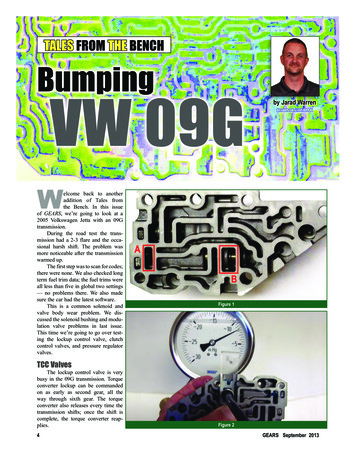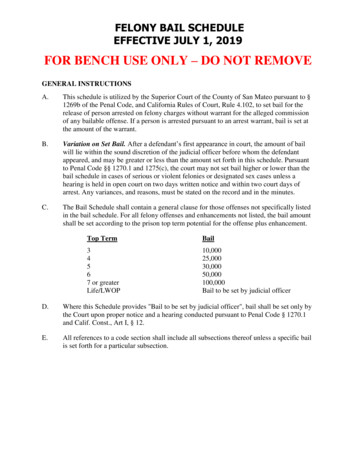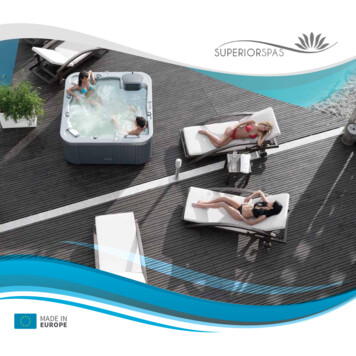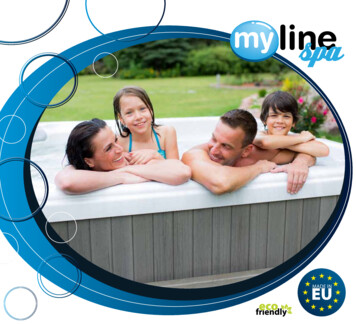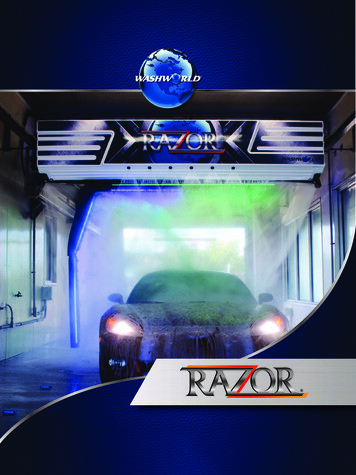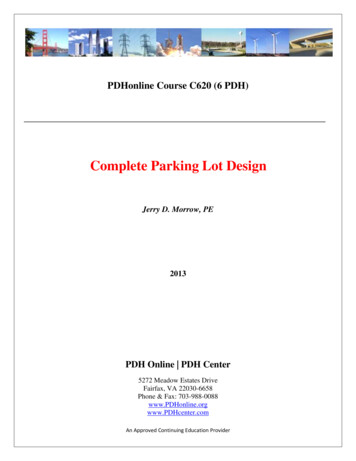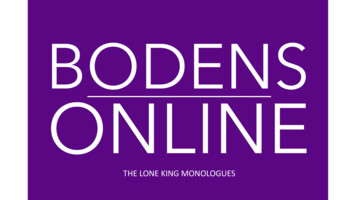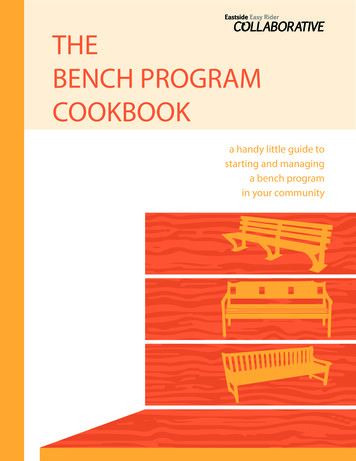
Transcription
THEBENCH PROGRAMCOOKBOOKa handy little guide tostarting and managinga bench programin your community
2014 - 2015 Eastside Easy Rider Collaborative
ContentsABOUT THE EERC 1Introduction 3Chapter 1:The Message 5Chapter 2:The Bench 9Chapter 3:The Plaque 17Chapter 4:The Location 21Chapter 5:The Foundation 29Chapter 6:The Maintenance 33Chapter 7:Program Costs 39Chapter 8:The Timeframes 43Chapter 9:The Marketing 45Afterword 47
Visit our website for additional information and resources:www.eastsideeasyrider.orgorCall the HopelinkMobility Coordinator:Phone: 425.943.6712Fax: 425.644.9956Email: mobility@hope-link.org
ABOUT THE EERCThe Eastside Easy Rider Collaborative (EERC) is a partnership of transportationservice providers, human service agencies, city staff, and other community stakeholders working together to identify and initiate coordinated, creative, andsustainable ways to assist special needs populations in East King County attain abetter quality of life by increasing their individual and collective transportation options.As the regional mobility coalition in East King County, TheEastside Easy Rider Collaborative (EERC) works to improveregional mobility awareness and access for special needspopulations in east King County through education, advocacy, coordination, and collaboration.The EERC pursues its mission by providing education, tools,and advocacy to address the mobility needs, challenges,and opportunities of special needs populations in East KingCounty. The Coalition identifies, monitors, supports, andinitiates solutions to assist special needs populations in EastKing County attain a better quality of life through increasingawareness of and access to relevant transportation optionswherever possible. The EERC meets with communitymembers, service providers, stakeholder groups, agency staff,and elected officials in order to ensure that access to necessary transportationservices and options for mobility challenged populations throughout the Eastsideis and remains a regional priory.1
2
IntroductionWelcome to the Eastside Easy Riders Collaborative’sguide to creating a Bench Program in yourcommunity!The purpose of this document is to create a framework to assist you in creating abench program in your community, your neighborhood, or wherever you think itmight work best. While we can’t give you a complete guide to every situation youmay encounter in your planning, we hope that this guide will help you find theresources you need.In order for people to stay active and independent, getting outside is a great firststep. But who wants to take that first step if there’s no place to take a rest? Theprospects can be daunting.Benches can add beauty and convenience and encourage people to pursue healthat their own pace. By providing frequent stopping/resting places, you are encouraging people to take a walk. Whether it’s in the woods, around the block, gettingto public transportation or just visiting your downtown businesses, benches canbe a real help to all.The Eastside Easy Rider’s Collaborative hopes that this guidebook provides youwith useful information and guidance on developing your own bench program inyour community.3
4
Chapter 1:The MessageIn order to begin a successful bench program the individual, group, or agencyinterested in pursuing this venture must be able to answer at least the followingquestions. Carefully consider each of these questions and take into account yourown aspirations and limitations. Doing this will result in a more thorough andorganized approach to improving your community.Why start a bench program in your community?You probably already know the answer to this question; it’s probably the reasonyou picked up this guidebook to begin with. Perhaps there are seniors in yourcommunity who need a place to rest as they walk to the store, children headingto school in need of a safe place to relax while waiting for the bus, or perhapsyou simply want to encourage walking and pedestrian activity at street levelfor reasons of safety and livability. These are some examples of good reasons tobegin a bench program in your community. You may have multiple reasons youwant to improve your community with benches. What’s yours?How many benches are you hoping for?Be realistic. Consider both the needs in your community you want to fill byinstalling a program of this nature as well as the resources available to you (bothcurrent and anticipated resources). Sprucing up a park or two in your neighborhood is a far simpler task than installing public seating on a citywide scale,for example. The size – both in terms of geography and population – of yourcommunity, as well as the financial, time, and political resources available shouldalso be taken into consideration. Additionally, it’s good to think about what kindof benches need to be installed in order to accomplish your goal. All of these5
factors must be considered in order to find a final number of benches that can berealistically obtained, installed, and maintained.What is the area you have defined to create thisprogram?Like the questions above, being clear about your geographic scope is critical insetting out on a community enhancement program such as this. Perhaps yourvision is just a one-time project to improve an area park and maintain thosebenches there. Perhaps you’d like to use your bench project as a pilot programwith hope that it will eventually grow throughout your community? Regardlessof your motivation, set a realistic goal for your initial efforts in terms of geography. You will need to be able to explain why your selected area (or areas) is inneed of benches and how you selected it over others.Who will most benefit from this program?While it’s easy to see how installing more public furniture like benches can bea benefit to all members of a community, it’s worth digging a little deeper thanthat. It will make your job easier if you are clear about what specific communityneed you are trying to fill. Is there a particular group that is in direct need ofplaces to sit and rest in a community? Take the time to identify that group (orgroups) and communicate with its members if possible to get firsthand accountsof their experiences. For instance: Does your community have a large senior population that would like to walk but is deterred by the lack of adequate pedestrianinfrastructure? Being clear about those who can benefit most from your benchprogram will help inform and explain why the need is there.Who is going to be responsible for which elements?Identifying stakeholders and roles in any program is a key to executing it successfully. Do you want your local government to run the program? Or would you6like to see private parties initiate the program on their own? Or perhaps a hybridpublic-private partnership is the way to go in order to share responsibility and
burden? Identifying who is important to this project is the first step to answeringquestions about where benches would go, how they will be maintained, andmore.If you want to go with the public sector, using your local government as theinitiator of the bench program, be aware the process might be slow and potentially cumbersome. It will likely have to be considered and debated by publicdecision-makers and boards, as well as local planners, which can take time. It willalso have to compete with other public projects that others may consider moreimportant or pressing than a bench program when dealing with limited publicresources. There will also be issues of whether your program is fair to all whengoing through the public sector – you must be able to explain in a democraticmanner why one neighborhood will receive new benches while another won’t,which can be difficult to do.Going through a private group, such as a local Chamber of Commerce or perhapsa private land owner such as a grocery store or other large property, can oftentimes avoid the bureaucracy of going through local government. Because thesegroups are not held to the same responsibilities as local governments, they canoften move more quickly and efficiently when they decide to act. But you mustmake the case to a private group about the benefit that benches on their propertywill bring. If you can convince a grocery store that it would increase its customerbase if benches were put in on the far end of the parking lot so that seniorswalking to the store could rest safely, perhaps a case can be made. It’s critical toremember that even the most civically minded business or property owners allhave a bottom line that they must consider before making any decisions affectingtheir capital costs.Forming a public-private partnership is also an option for beginning a capital improvement project like a bench program. These arrangements can be creativelyorganized to sidestep many issues like cost or equity debates in order to expeditethe program’s implementation. New York City’s Citibike program (https://www.citibikenyc.com) is one such example of a public-private project that becamesuccessful because of the specific arrangement and responsibilities divided up7
between the public and private sector stakeholders. In the case of Citibike, thepublic sector identified the need for more multimodal transportation, did muchof the research and planning for what a successful bike-share program wouldlook like, and took steps to improve bicycle infrastructure on city streets. But theprogram itself was initialized and managed by a private limited liability corporation. This allowed the program to implement on a scale that would make theprogram successful while setting the stage for future growth, but resulted in theprogram not serving all areas of the city equally. The public-private partnershipoption also allows for cost sharing between both sectors, releasing some strainon local governments likely already struggling with their budgets and passingsome costs on to the private sector, provided the benefit to their interests is alsoapparent.What do you want to name your program?Finally, every good program needs a good name and branding. Think of something that is clear and catchy, and communicates the mission of your benchprogram. Depending on how big a program you want, proper name recognitionand branding may be more or less important. Letting the community knowwhat’s going on can be a very valuable tool for building public support. Based onyour available resources, you may want to consider hiring a marketing firm toassist with this process, as they often have expertise in developing branding andoutreach campaigns that can effectively and efficiently inform the public.8
Chapter 2:The BenchWhere can you find suitable benches for installation?Who are some Washington State vendors?Benches can be located and purchased from a variety of locations and vendors.While many basic models can be purchased at a hardware store like Home Depotor a similar scale store that carries large-scale hardware, for commercial gradebenches the standard avenue is typically through a specialty vendor, often foundonline. The easiest way to find the online vendors is to do a search for “sitefurniture” rather than “benches.” Some of these vendors include companies likeSightlines (www.sightlinesinc.com/) or Northwest Playground (www.nwplayground.com/), many of which have business operations available online. Anotheris Fairweather Site Furnishings (http://fairweathersf.com/benches/). At thesecommercial grade bench producers, one can expect to find benches built to lasta long time, suitable for public infrastructure, as opposed to private use whichusually inflicts significantly less wear and tear on the bench.What are typical price ranges for benches?Benches can range in price significantly. Like most products, the price of a benchis a combination of materials and labor (not installation, which will be an additional cost), as well as shipping. The typical range of bench pricing from a commercial vendor is anywhere between 200 and 600. Obviously materials andassembly quality improve as price increases. Bulk purchases as well as shoppingaround can yield significant savings. Shipping is where costs can significantlyincrease if you’re not careful. If benches are purchased from a non-local vendor,you can reasonably expect to pay the same amount in shipping charges as the9
bench itself (two- to six hundred dollars per bench). This is a great reason to shoplocally before exploring options with distant vendors.What are some of the ways they can be affixed tothe ground/foundation? What are some of themethods used?This gets a bit technical so bear with us here. Benches can be affixed to theground any number of ways. The most popular methods of securing bench foundations in the greater Seattle area (and in most urban metro regions) are eitherthe traditional or “rod” style or the “boltdown” style. Both types of foundationsuse concrete as a foundation base, though a boltdown style bench does not technically have to. In rod style foundations the benchsupport rods puncture through a concrete slabwhich can rest on top of, at grade with, or belowthe ground surface. With boltdown style benches,a concrete slab is poured as a foundation (just likewith rod style) but instead of the bench’s supportrods piercing through the concrete and into the“Bolts” affipoured conground, they are usually only the length necessaryto have the bench sit at its desired height on top ofthe concrete slab which is poured at surface gradeand remaining unburied. The bottom of bench’ssupport rods (where they make contact with the foundation) have widened feetor pedestals flaring outwards from their base. Those feet rest on the concrete padand are then literally bolted into the concrete slab on which the bench is placed.The boltdown style tends to be more popular inurban settings, as it allows for easier replacementand isn’t inferior in terms of structural soundnessto the more labor-intensive rod
Like the questions above, being clear about your geographic scope is critical in setting out on a community enhancement program such as this. Perhaps your vision is just a one-time project to improve an area park and maintain those benches there. Perhaps you’d like to use your bench project as a



